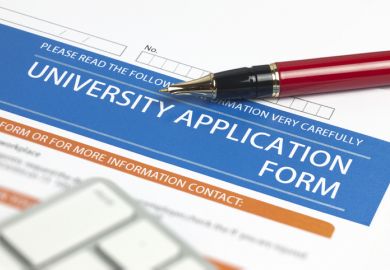The number of applications to UK universities has fallen from last year’s peak, figures show, with the proportion applying to elite institutions hitting record levels.
Final deadline data from Ucas shows 319,570 UK 18-year-olds applied by the June 30 deadline – 2 per cent fewer than in 2022, though still the second-highest on record.
Reversing last year’s trend, 40.8 per cent of their applications were to higher-tariff institutions – the joint-highest on record.
This suggests young applicants have not so far recalibrated their ambition after the cutbacks in UK intakes at those universities last year, Mark Corver, dataHE co-founder, told Times Higher Education.
The number of applications to lower-tariff providers from UK 18-year-olds fell by 4 per cent, which was the largest drop in six years.
Mr Corver said the demand dynamic from the UK was “notably weak” on two separate fronts: the application rate for UK 18-year-olds fell by a record amount, and demand from older applicants was also down.
Mr Corver said that when reapplicants – who are probably an echo of the difficult entry environment last year – were stripped out, new demand from older age groups had slumped to its lowest-ever level.
“With application rates falling again over most older age groups, the long journey that lower-tariff providers have been on in reorienting away from this important market for them does not seem to be over yet,” he added.
The figures also revealed the largest-ever recorded fall (3 per cent) in the number of female applicants.
Janet Ilieva, founder of education consultancy Education Insight, said it was not a surprise to see a reduction in the application rate for 18-year-olds.
“Typically, the opportunity cost of education is low when the employment prospects are limited,” she said.
“It is quite the opposite at the moment: the unemployment rate is at one of its lowest levels for almost five decades.
“This means the employment alternative to higher education is significantly more attractive.”
Tim Bradshaw, chief executive of the Russell Group, said he was pleased to see young people continue to be ambitious with their choices for higher education.
“While competition for places at top universities remains high, there is a welcome increase in the proportion of students holding firm offers from their preferred universities this year.
“This reflects increased confidence in offer-making by institutions as school exam grading returns to the pre-pandemic profile.”
The Ucas data also showed that a record number of UK 18-year-olds applied to computing courses, ranking it above law for the first time and the seventh most popular overall.
The rise in the number of computing applications was driven by increased interest in computer science, software engineering and artificial intelligence.
While computing saw the biggest increase in applicants (10 per cent), there were notable falls for combined and general studies (12 per cent), education and teaching (10 per cent) and agriculture, food and related studies (10 per cent).
Clare Marchant, chief executive of Ucas, said: “We know that changes in the world around us translate into increased demand for certain courses, as we saw for economics post-2008, and for medicine and nursing during the Covid-19 pandemic.
“These new figures suggest students are becoming increasingly inspired to study computing thanks to the rise of digital and AI.”
Register to continue
Why register?
- Registration is free and only takes a moment
- Once registered, you can read 3 articles a month
- Sign up for our newsletter
Subscribe
Or subscribe for unlimited access to:
- Unlimited access to news, views, insights & reviews
- Digital editions
- Digital access to THE’s university and college rankings analysis
Already registered or a current subscriber?








